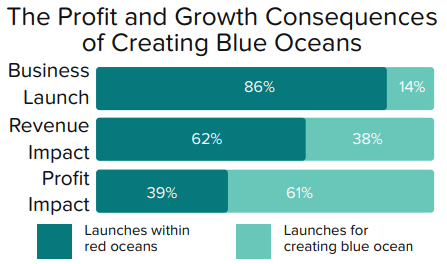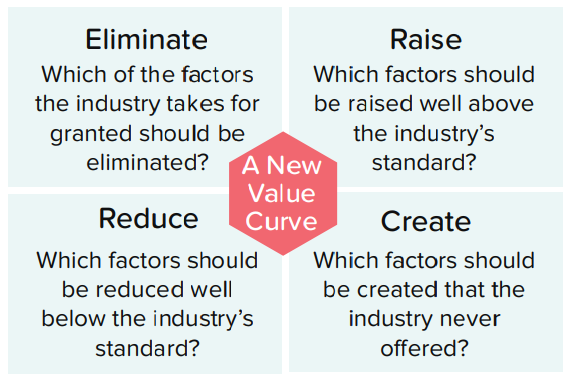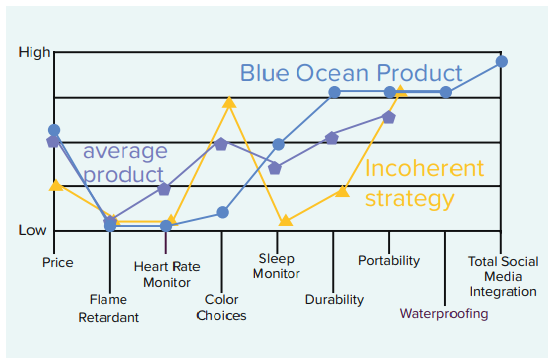How to Create a Startup: The Blue Ocean Strategy
Learn how to create uncontested market space and make your competition irrelevant
Highlights:
- Discover a bold business strategy that rewards innovation and casts competition aside.
- Equip yourself with the analytical tools necessary to implement a Blue Ocean Strategy.
- Learn target costing and strategic pricing.
Summary of BLUE OCEAN STRATEGY: Creating Blue Oceans and Blue Ocean Analytic Tools
 |
| Source: Kim, WC & Mauborgne, R 2015, Blue ocean strategy, exp. edn. p. 7. HBS Publishing, Boston. |
Comparing Two Oceans
- Blue Oceans: Untapped market space free of competition, where firms can create customers. Blue oceans have the potential to provide rapid profit growth.
- Red Oceans: Established markets with entrenched industry practices and intense competition for profits.
- Strategic move: The set of decisions a firm makes to create blue oceans.
- Value innovation: Creating an increase in value to customers while reducing firm costs, rendering competitors irrelevant.
- Value-cost trade-off: The paradigm of many competitive strategies in which greater value comes at a greater cost and lower value comes at a lower cost.
The Strategy Canvas
- Strategy Canvas: A tool used to illustrate a company’s competitive strategy.
- Factors of competition: Factors that an industry competes on and invests in; for example, price.
- Value curve: A line made by plotting a company’s profile across a strategy canvas.
Optimizing Strategy
Four actions framework: Four questions used to facilitate understanding or formulation of a company strategy.
Eliminate-reduce-raise-create (ERRC) grid: A helpful tool used to complement the four actions framework.
Successful Blue Ocean Strategy has three hallmarks:
- Focus: An emphasis on only key factors of competition.
- Divergence: A break from an industry’s prevailing strategies.
- Compelling tagline: e.g. Southwest’s, “The speed of a plane at the price of a car—whenever you need it.”
Reading Value Curves
High investment across all factors signifies overdelivering without payback: investing in options or features that add little value for consumers.
Zigzags indicate a corporation with an incoherent strategy. A divergent curve indicates a blue ocean product.
Strategic Pricing
Price corridor of the mass: A process for finding an optimal price point involving the following two steps:
- Identify any existing alternatives to your product, either with differing forms and the same function, or differing form and function, but the same objective.
- Examine the price and user base of each alternative
Network externalities: A phenomenon in which people place little value on a product used by few others. This makes setting a strategic price crucial.
Nonrival goods: Resources anyone can use.
Low excludability: Causes a product to be vulnerable if it doesn’t have a limitation on its use by rival firms.
Target Costing
Three levers of cost reduction:
- Streamlining: Simplifying and optimizing operations.
- Partnering: Forming strategic alliances to share cost burden with other firms.
- Pricing innovation: Changing the way a product or service is monetized, e.g., Blockbuster’s choice to rent videotapes to consumers rather than to sell them.
Strategic Sequence
Strategic sequence: A four-step process for formulating and evaluating blue ocean ideas.
- Buyer utility: The amount of value a product or service delivers to a buyer. This can be increased either by pulling one of the six utility levers, or by removing blocks to buyer utility.
- Strategic pricing: Setting a price that will attract the greatest number of customers in the shortest amount of time.
- Target costing: Using insights gained from determining optimal price points to set your target cost of production.
- Adoption: Ensure smooth adoption by engaging and educating the three primary stakeholders: employees, business partners, and the general public.
Blue Ocean Idea Index: A birds-eye view of the commercial viability of blue ocean ideas.









